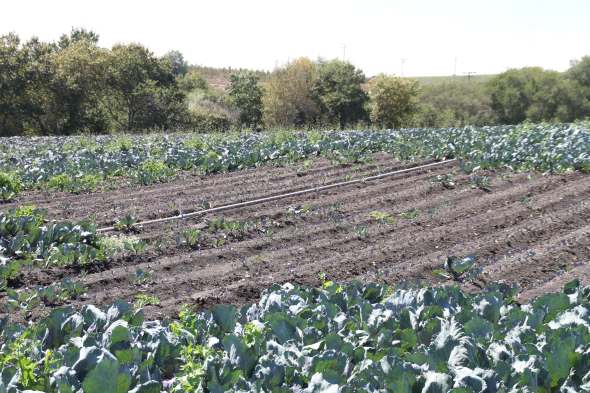9 Things You Need To Know About Garden Symphylan

This photo shows garden symphylan damage in a broccoli field.
Photo credit: Shimat Joseph
Several arthropods live in the soil and flourish. Some use soil to overcome the adverse season, such as cold temperatures in the winter months, whereas others temporarily use soil to complete part of their life cycle.
One such organism that spends its entire life in the soil is the garden symphylan. This arthropod is a pale or whitish, delicate, ¼-inch-or-less-long centipede-like organism with 6 to 12 pairs of legs. It feeds on the organic matter and fungi in the soil and on live plant roots. The garden symphylan is a sporadic pest in some fields, but it can be a serious pest in others.
The severity of the problem can vary by region and growing season. This pest feeds on tender roots of both direct-seeded and transplanted crops alike, causing severe stunting and plant mortality. Typically, the affected plants are found in a discrete patch or spot within the field.
The garden symphylan is neither an invasive arthropod nor an emerging pest issue. Instead it is a pest problem that has persisted for several decades in the Western states. Here are nine things to be aware of when trying to manage this pest of vegetable crops.
1. An unpredictable pest
In one growing season, garden symphylan infestation can be a very visible problem, and the next season, it may not even show up in the same field. Sometimes, the infestation appears with no notable warning signs. Plus, the distribution of garden symphylan within a field can move between growing seasons.
It is believed that garden symphylans use the channels created by other soil organisms, such as earthworms, for vertical and lateral movement through the soil profile. The soil tillage, which essentially provides aeration to the growing roots, may also create access points for the garden symphylans dwelling beneath the soil layers. As a result, the damage spot in the field can shift from one area to another within the same field.
2. Aggregate in large numbers
Because garden symphylans access the plant roots through certain spots in the field, they tend to aggregate in very large numbers in those spots. The persistent feeding behavior possibly affects the normal root development leaving the plants stunted as they fail to translocate the water and nutrients.
3. High level of mobility
Garden symphylans are highly mobile in the soil with speeds from less than a quarter of an inch per second to 1.5 inches per second. The ability to move quickly may help them evade predators, unfavorable conditions, or insecticides applied in the soil.
4. Soil type, moisture impact activity
Garden symphylans are capable of moving to the deeper profiles of the soil when the conditions are unfavorable in the upper soil layers. Factors such as soil type, organic matter, temperature, and moisture affect their activity in the upper soil profile.
Generally, the incidence of garden symphylan problems is widely observed in the heavier or clay soils with higher organic matter content than in the lighter or sandy soils. The soil moisture and temperature influence their seasonal movement within the soil.
In the Central Coast of California, seedlings both from transplants and direct-seeded crops are on an intense water schedule, and these conditions are likely helping this pest move up to the upper layers of the soil and remain active. Often, their numbers decline as the water content in the upper soil layers decreases especially when the watering schedule relaxes after plant establishment. To survive in the soil, the garden symphylans require a humid environment.
5. Well adapted to the soil
This pest spends its entire life in the soil and is well adapted to the subterranean habits. Garden symphylans have no eyes but have long antennae and thousands of sensory hairs all over the body. It is believed that these sensory hairs help them to feel and taste the surrounding environment.
6. Wide host range
The garden symphylans have shown the ability to feed on roots of multiple plant hosts. This includes both commercially grown crops and unmanaged weed plants outside the field. In the Central Coast of California, all the high-value crops such as lettuce, strawberry, broccoli, cauliflower, pepper, celery, and garlic are affected by this pest. Some growers monitor the health of weed plants around the field to predict the presence of garden symphylans.
7. Non-chemical controls may not fit production practices
Several non-chemical tactics such as crop rotation, planting less-susceptible crops, flooding, intensive tillage, and conservation of beneficial organisms have been suggested. The success and effectiveness of these tactics have been limited because growers were unable to fit them into current production practices or the business model that involves susceptible high-value crops, irregular topography, and enormous population size.
8. Insect controls need to move to the root zone
To control garden symphylan, the most desirable quality of an insecticide is longer residual activity of the insecticide at the root zone of the plant. This activity provides protection up to plant establishment. The reduced-risk insecticides do not move readily into the root zone, either because of reduced water solubility or the tendency to bind to soil organic matter.
In some cases, the insecticides quickly break down in soil and, as a result, the desired active insecticide agent may not be available when garden symphylans come in contact with the soil.
9. Better insecticide application methods needed
The current insecticide application methods may not entirely place insect control products into the root zone. In California’s Central Coast, insecticides are typically applied to the seed line after planting the seeds or at the crown area of the plants, anticipating that the applied insecticide will eventually move into the root zone. Improved insecticide placement methods would improve garden symphylan control.
For these reasons, reliable management of garden symphylans is difficult to achieve. As a result, some growers in the Central Coast of California are reluctant to plant high-value crops in the fields with a history of garden symphylan problems. Others who are still planting crops in fields that had issues with garden symphylan are prepared to embrace some crop loss.










